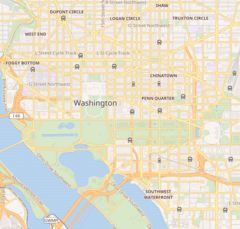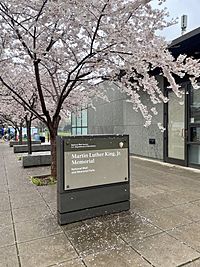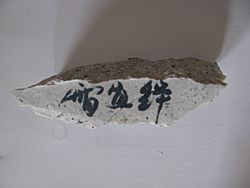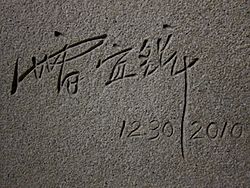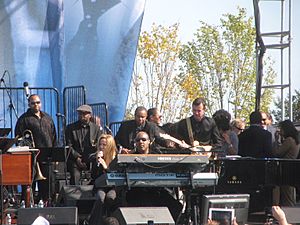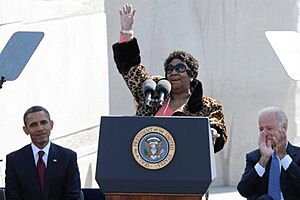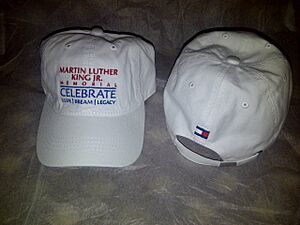Martin Luther King Jr. Memorial facts for kids
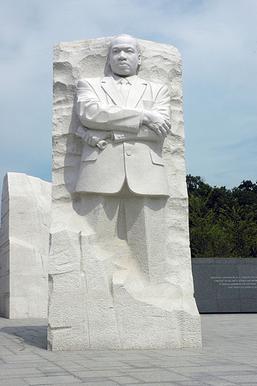
The Stone of Hope at the Martin Luther King, Jr. Memorial
|
|
| Coordinates | 38°53′10″N 77°2′39″W / 38.88611°N 77.04417°W |
|---|---|
| Location | 1964 Independence Ave. SW, Washington, D.C. |
| Designer | Lei Yixin |
| Material | Softened White Granite |
| Length | 1000 |
| Width | 1000 |
| Height | 30 ft (9.1 m) |
| Beginning date | 2009 |
| Completion date | 2011 |
| Opening date | August 22, 2011 |
| Dedicated to | Martin Luther King Jr. |
| Website | Martin Luther King, Jr. Memorial |
The Martin Luther King, Jr. Memorial is a special place in Washington, D.C., United States. It is a national memorial located in West Potomac Park, right next to the famous National Mall. This memorial covers about 4 acres of land.
Its main feature is the Stone of Hope. This is a large granite statue of civil rights movement leader Martin Luther King Jr.. A sculptor named Lei Yixin carved it. The idea for the memorial comes from a line in King's famous "I Have a Dream" speech. He said, "Out of the mountain of despair, a stone of hope."
The memorial first opened to visitors on August 22, 2011. It took over 20 years of planning, raising money, and building to complete. This memorial is the 395th site managed by the United States National Park Service (NPS).
You can find the memorial near the Tidal Basin. It is close to the Franklin Delano Roosevelt Memorial. It also lines up visually with the Lincoln Memorial and the Jefferson Memorial. The memorial's address, 1964 Independence Avenue, S.W., honors the important Civil Rights Act of 1964.
A special ceremony to dedicate the memorial happened on October 16, 2011. It was first planned for August 28, 2011. That date was the 48th anniversary of King's "I Have a Dream" speech. However, Hurricane Irene caused the event to be postponed.
This memorial is not the first to honor an African American in Washington, D.C. But Martin Luther King Jr. is the first African American to have a memorial on or very close to the National Mall. He is also only the fourth non-president to be honored this way. The National Park Service takes care of the King Memorial.
Contents
Who Was Martin Luther King Jr.?
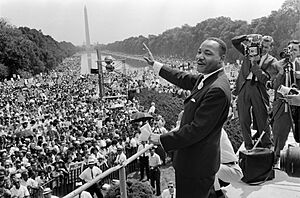
Martin Luther King Jr. was born on January 15, 1929, and passed away on April 4, 1968. He was an American clergyman and a very important leader in the Civil Rights Movement. He worked hard to advance civil rights in the United States and around the world.
King believed in using nonviolent ways to protest. He was inspired by Mahatma Gandhi. At the 1963 March on Washington for Jobs and Freedom, King gave his famous "I Have a Dream" speech. In this speech, he shared his vision for an end to racial inequality. Many people consider this speech one of the greatest in American history.
In 1964, King received the Nobel Peace Prize. He was the youngest person at that time to win it. He earned the prize for his efforts to end racial segregation and racial discrimination. He used peaceful methods like civil disobedience.
Before he passed away, King also focused on ending poverty and stopping the Vietnam War. He was helping with a workers' strike in Memphis, Tennessee. He was also planning a large protest in Washington, D.C., called the Poor People's Campaign. Martin Luther King Jr. was assassinated in Memphis on April 4, 1968.
Why Was the Memorial Built?
The idea for the King Memorial came from the Alpha Phi Alpha fraternity. Martin Luther King Jr. was a member of this fraternity. After King's assassination in 1968, the fraternity wanted to build a lasting memorial to him in Washington, D.C.
Their efforts gained speed in 1986. That year, King's birthday became a federal holiday, Martin Luther King Jr. Day. In 1996, the U.S. Congress allowed Alpha Phi Alpha to build a memorial on government land. They had until 2003 to raise $100 million and start building.
In 1998, Congress approved a special foundation to manage the memorial's fundraising and design. This foundation was called the Washington, D.C. Martin Luther King Jr. National Memorial Project Foundation, Inc. The site for the memorial on the National Mall was approved in 1999.
The design for the memorial was chosen from 900 ideas from 52 countries. A company called ROMA Design Group created the winning design. On December 4, 2000, a special plaque was placed to mark the future site.
Building the memorial officially began on November 13, 2006. By December 2008, the foundation had raised about $108 million. Many groups and people donated, including General Motors, Tommy Hilfiger, and the Bill and Melinda Gates Foundation. The U.S. Congress also gave $10 million. Construction was completed in 2011.
What Does the Memorial Look Like?
Location and Meaning
The memorial's address is 1964 Independence Avenue SW. The number "1964" was chosen to remember the 1964 Civil Rights Act. This law was a huge step in the Civil Rights Movement, and King played a big part in it.
The memorial is on a 4-acre site in West Potomac Park. It is next to the Tidal Basin. It is also near the Franklin Delano Roosevelt Memorial. The design connects it visually to the Lincoln Memorial. This is important because King gave his "I Have a Dream" speech on the steps of the Lincoln Memorial.
Main Structure
The main part of the memorial is inspired by King's "I Have a Dream" speech. He said, "Out of the mountain of despair, a stone of hope."
Visitors first walk through two large pieces of granite. These represent the "mountain of despair." Then, they see the Stone of Hope. This is a 30-foot-high statue of King. It looks like he is stepping out of the mountain. The Stone of Hope is made of light pink granite from China. This color helps the details stand out, especially at night. It also makes it different from the darker "mountain of despair." This journey through the memorial shows how King moved through struggles in his life.
There is also a 450-foot-long wall called the Inscription Wall. It has quotes from King's speeches and sermons. Fourteen of his quotes are carved into this crescent-shaped granite wall. The earliest quote is from 1955, during the Montgomery bus boycott. The latest is from his last sermon in 1968, just four days before he was assassinated.
The statue of King faces the Tidal Basin. It looks out towards the horizon. Cherry trees are planted around the memorial. They bloom each year around the anniversary of King's passing.
Other Memorials Honoring African Americans
This memorial is not the first in Washington, D.C., to honor an African American. There is also a memorial to Mary McLeod Bethune. She founded the National Council of Negro Women. Her 17-foot-tall bronze statue is in Lincoln Park. However, the King Memorial is the first to honor an African American on or very close to the National Mall.
Important Inscriptions
The Inscription Wall has fourteen quotes from King's speeches and writings. A group of historians helped choose these quotes. The quotes focus on four main ideas from Dr. King: justice, democracy, hope, and love.
The quotes are not in order by date. This means visitors can start reading anywhere. None of the quotes on this wall are from his famous "I Have a Dream" speech. This is because the whole memorial is based on that speech.
Some of the quotes on the Inscription Wall include:
- "Darkness cannot drive out darkness, only light can do that. Hate cannot drive out hate, only love can do that."
- "Injustice anywhere is a threat to justice everywhere."
- "I have the audacity to believe that peoples everywhere can have three meals a day for their bodies, education and culture for their minds, and dignity, equality and freedom for their spirits."
- "True peace is not merely the absence of tension: it is the presence of justice."
The Stone of Hope also has two statements from King. One side says, "Out of the Mountain of Despair, a Stone of Hope." This is the main idea for the memorial. The other side used to have a quote that was changed in 2013. It now reflects King's full words: "If you want to say that I was a drum major, say that I was a drum major for justice. Say that I was a drum major for peace. I was a drum major for righteousness. And all of the other shallow things will not matter."
Opening and Dedication
The memorial opened to visitors on August 22, 2011. The official dedication ceremony was held on October 16, 2011. It was a smaller event than originally planned.
President Barack Obama, First Lady Michelle Obama, and Vice President Joe Biden attended. Many other important people were there, including civil rights leaders and members of the King family. Singers like Aretha Franklin, Stevie Wonder, and Sheryl Crow performed.
President Obama gave a speech at the dedication. He talked about how the Civil Rights Movement connected to challenges faced today. He reminded everyone that change takes time and effort. He said, "Our work is not done." He encouraged people to keep pushing for a better future, just as Dr. King did.
On August 28, 2011, the memorial officially became a United States national park. The National Park Service now manages its daily operations and upkeep.
Images for kids
See also
 In Spanish: Monumento a Martin Luther King, Jr. para niños
In Spanish: Monumento a Martin Luther King, Jr. para niños
- Martin Luther King Jr. Memorial Library
- Civil rights movement in popular culture
- List of memorials to Martin Luther King Jr.
- List of national memorials of the United States


